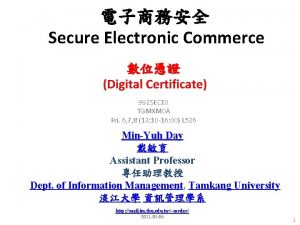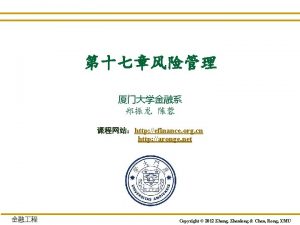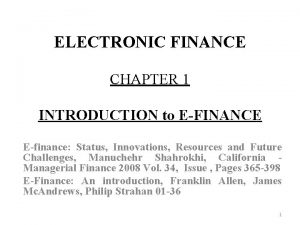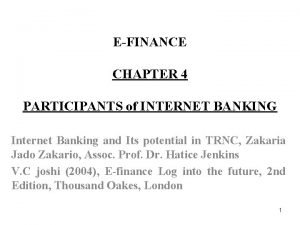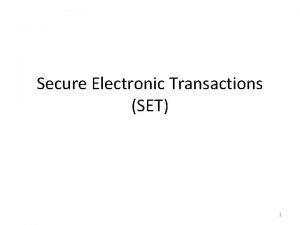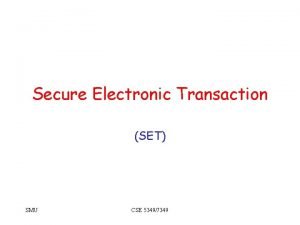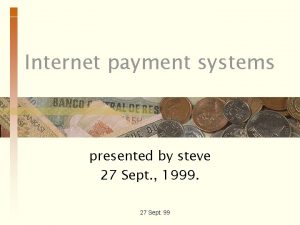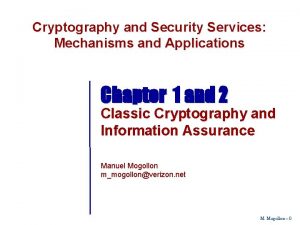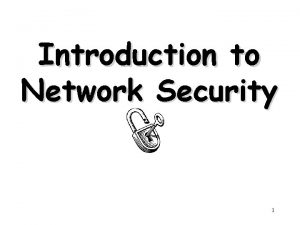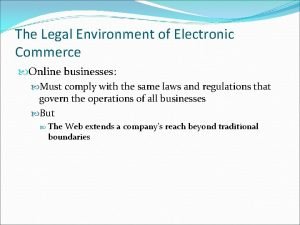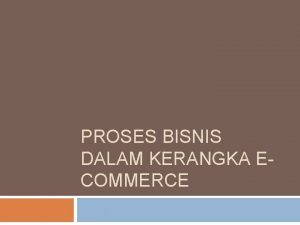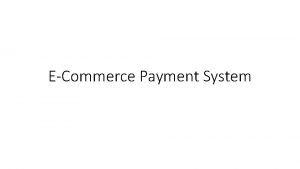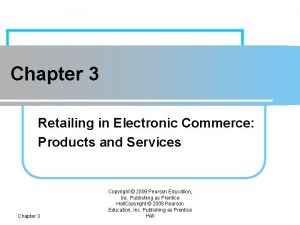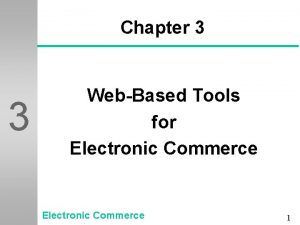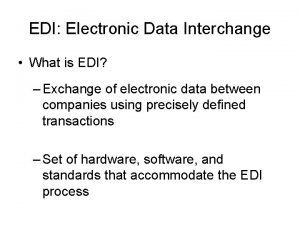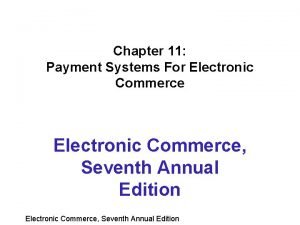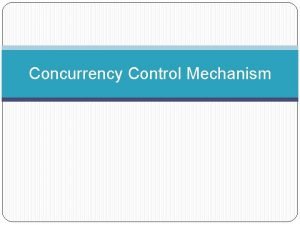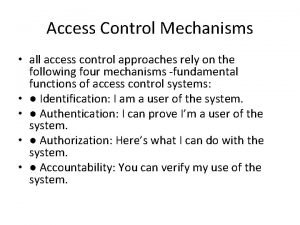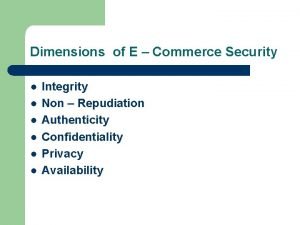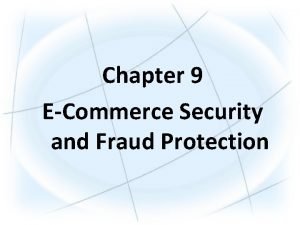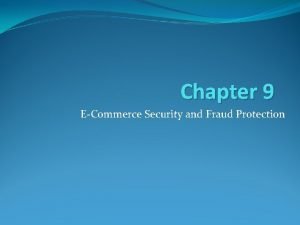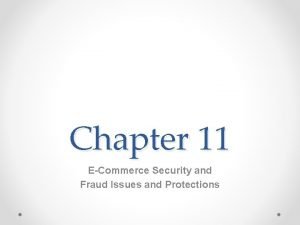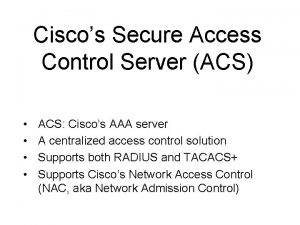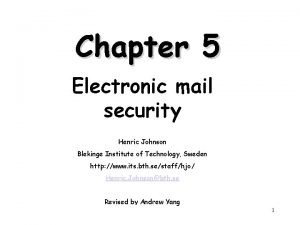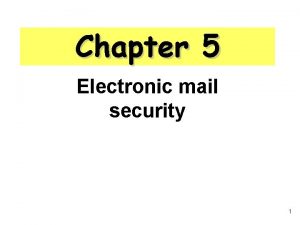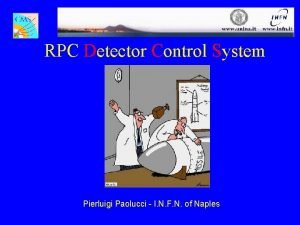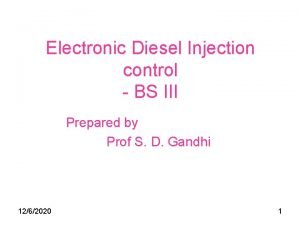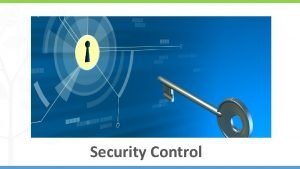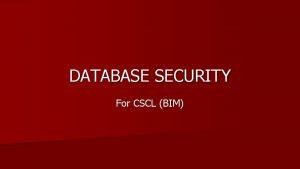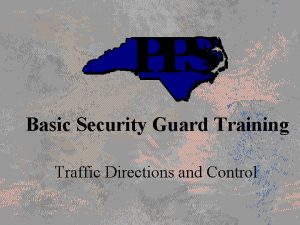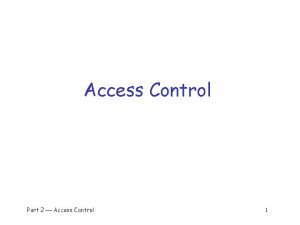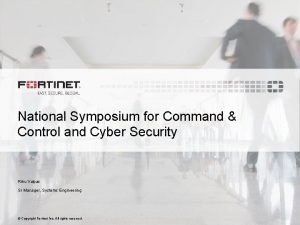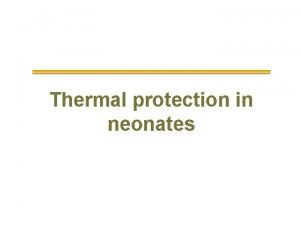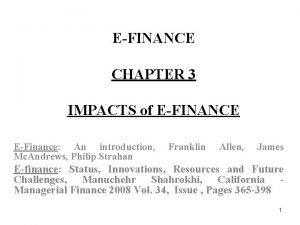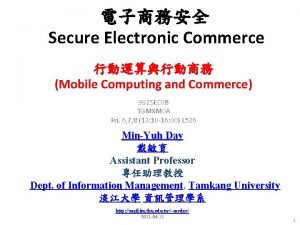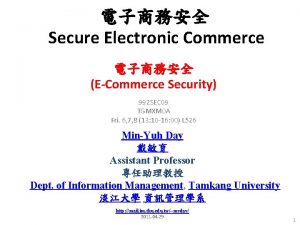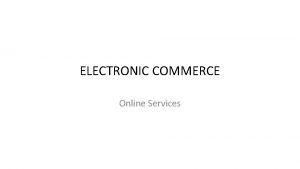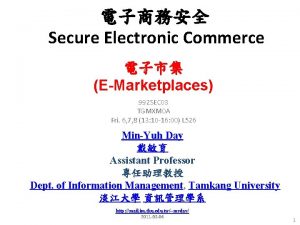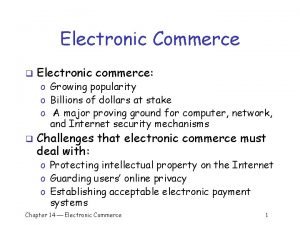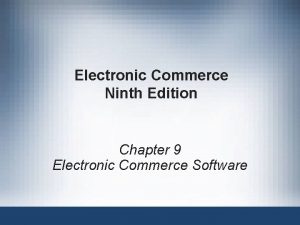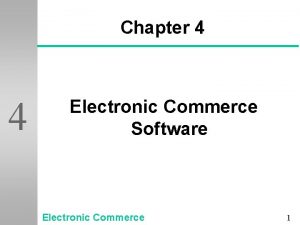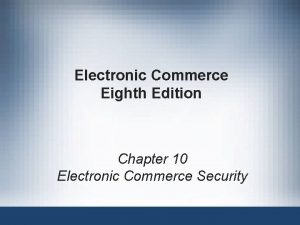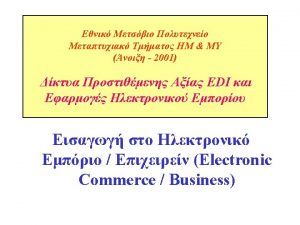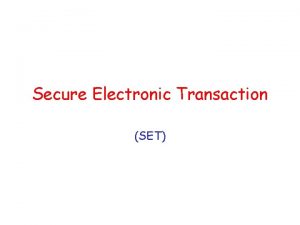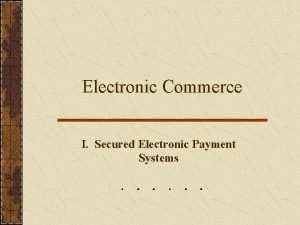Secure Electronic Commerce EFinance Security Control Mechanisms 992



















































































- Slides: 83

電子商務安全 Secure Electronic Commerce 電子金融安全控管機制 (E-Finance Security Control Mechanisms) 992 SEC 14 TGMXM 0 A Fri. 6, 7, 8 (13: 10 -16: 00) L 526 Min-Yuh Day 戴敏育 Assistant Professor 專任助理教授 Dept. of Information Management, Tamkang University 淡江大學 資訊管理學系 http: //mail. im. tku. edu. tw/~myday/ 2011 -06 -03 1

Syllabus 週次 月/日 內容(Subject/Topics 1 100/02/18 電子商務安全課程簡介 (Course Orientation for Secure Electronic Commerce) 2 100/02/25 電子商務概論 (Introduction to E-Commerce) 3 100/03/04 電子市集 (E-Marketplaces) 4 100/03/11 電子商務環境下之零售:產品與服務 (Retailing in Electronic Commerce: Products and Services) 5 100/03/18 網路消費者行為、市場研究與廣告 (Online Consumer Behavior, Market Research, and Advertisement) 6 100/03/25 電子商務 B 2 B、B 2 C、C 2 C (B 2 B, B 2 C, C 2 C E-Commerce) 7 100/04/01 Web 2. 0, Social Network, Social Media 8 100/04/08 教學行政觀摩日 9 100/04/15 行動運算與行動商務 (Mobile Computing and Commerce) 10 100/04/22 期中考試週 2

Syllabus (cont. ) 週次 月/日 內容(Subject/Topics 11 100/04/29 電子商務安全 (E-Commerce Security) 12 100/05/06 數位憑證 (Digital Certificate) [Module 4] 13 100/05/13 網路與網站安全 (Network and Website Security) [Module 5] 14 100/05/20 交易安全、系統安全、IC卡安全、電子付款 (Transaction Security, System Security, IC Card Security, Electronic Commerce Payment Systems) [Module 6, 7, 8, 9] 15 100/05/27 行動商務安全 (Mobile Commerce Security) [Module 12] 16 100/06/03 電子金融安全控管機制 (E-Finance Security Control Mechanisms) [Module 13] 17 100/06/10 營運安全管理 (Operation Security Management) 18 100/06/17 期末考試週 3







基本防範措施 1. Port Scanning 2. SNMP Scanning 3. Enumeration & Banner Grabbing 4. Wireless Enumeration 5. Vulnerability Scanning 6. Host Evaluation 7. Network Device Analysis 8. Password Compliance Testing 9. Application Specific Scanning 10. Network Sniffing 教育部顧問室編輯 “電子商務安全”教材 13 - 10

基本防範措施 1. Port Scanning – Identify enabled network services on systems – Look for unauthorized services or backdoors 2. SNMP Scanning – Enumerate systems on the network – Identify community strings 3. Enumeration & Banner Grabbing – Verification of operating system 4. Wireless Enumeration Tools – Identify access points and potential exposures 5. Vulnerability Scanning – Identify well-known vulnerabilities on systems 教育部顧問室編輯 “電子商務安全”教材 13 - 11

基本防範措施 6. Host Evaluation – Analyze configuration, discretionary access control and policies 7. Network Device Analysis – Analyze security architecture for well-known vulnerabilities and insecure configurations 8. Password Compliance Testing – Evaluate adherence to password policy and determine whether password filters are being effectively implemented 9. Application Specific Scanning – Evaluate security configuration of critical applications 10. Network Sniffing – Identifies sensitive information traversing the network (log-in, passwords, server configurations via telnet, etc) 教育部顧問室編輯 “電子商務安全”教材 13 - 12


1. Port Scanning Use Super. Scan tool 教育部顧問室編輯 “電子商務安全”教材 13 - 14



2. SNMP Scanning Use Solar. Winds SNMPweep tool 教育部顧問室編輯 “電子商務安全”教材 13 - 17

2. SNMP Scanning Use Solar. Winds IP Network Browser tool 教育部顧問室編輯 “電子商務安全”教材 13 - 18


3. Enumeration Use finger tool on UNIX 教育部顧問室編輯 “電子商務安全”教材 13 - 20

3. Enumeration Use rpcinfo tool on UNIX 教育部顧問室編輯 “電子商務安全”教材 13 - 21

3. Banner Grabbing Use Super. Scan tool 教育部顧問室編輯 “電子商務安全”教材 13 - 22

3. Banner Grabbing 輸入GET Use telnet (80) tool 教育部顧問室編輯 “電子商務安全”教材 13 - 23

3. Banner Grabbing FTP 使用 21 PORT ? Use telnet (21) tool 教育部顧問室編輯 “電子商務安全”教材 13 - 24

4. Wireless Enumeration Use Network Stumbler tool 教育部顧問室編輯 “電子商務安全”教材 13 - 25

5. Vulnerability Scanning Use Nessus tool 教育部顧問室編輯 “電子商務安全”教材 13 - 26

5. Vulnerability Scanning Use Ne. WT Security Scanner tool 教育部顧問室編輯 “電子商務安全”教材 13 - 27

5. Vulnerability Scanning 教育部顧問室編輯 “電子商務安全”教材 Use Saint tool 13 - 28

5. Vulnerability Scanning Use IBM Internet Security Scanner tool 教育部顧問室編輯 “電子商務安全”教材 13 - 29

6. Host Evaluation Use CIS Windows Benchmark tool 教育部顧問室編輯 “電子商務安全”教材 13 - 30

6. Host Evaluation Use MS-Baseline Security Analyzer tool 教育部顧問室編輯 “電子商務安全”教材 13 - 31

6. Host Evaluation Use Dame. Ware NT Utility tool 教育部顧問室編輯 “電子商務安全”教材 13 - 32

7. Network Device Analysis Use Insightix tool 教育部顧問室編輯 “電子商務安全”教材 13 - 33

8. Password Compliance Testing Use L 0 phtcrack tool 教育部顧問室編輯 “電子商務安全”教材 13 - 34

9. Application Specific Scanning Use Wikto tool 教育部顧問室編輯 “電子商務安全”教材 13 - 35

9. Application Specific Scanning Use Web. Inspect tool 教育部顧問室編輯 “電子商務安全”教材 13 - 36

9. Application Specific Scanning Use NGS Squirrel tool 教育部顧問室編輯 “電子商務安全”教材 13 - 37

10. Network Sniffing Use Ethereal tool 教育部顧問室編輯 “電子商務安全”教材 13 - 38


其他防範措施 • 網站應用系統弱點 – http: //www. owasp. org – Top 10 in 2007 A 1 – Cross Site Scripting (XSS) A 2 – Injection Flaws A 3 – Malicious File Execution A 4 – Insecure Direct Object Reference A 5 – Cross Site Request Forgery (CSRF) A 6 – Information Leakage and Improper Error Handling A 7 – Broken Authentication and Session Management A 8 – Insecure Cryptographic Storage A 9 – Insecure Communications A 10 – Failure to Restrict URL Access 教育部顧問室編輯 “電子商務安全”教材 13 - 40

其他防範措施 • 網站應用系統弱點 • https: //www. owasp. org/index. php/Category: OWASP_Top_Ten_Project • • • The OWASP Top 10 Web Application Security Risks for 2010 A 1: Injection A 2: Cross-Site Scripting (XSS) A 3: Broken Authentication and Session Management A 4: Insecure Direct Object References A 5: Cross-Site Request Forgery (CSRF) A 6: Security Misconfiguration A 7: Insecure Cryptographic Storage A 8: Failure to Restrict URL Access A 9: Insufficient Transport Layer Protection A 10: Unvalidated Redirects and Forwards 13 - 41



































總結Summary • 資安攻擊型態與演進Types of Attacks – 內部不當網路存取(59%) Insider abuse of Net access – 電腦病毒感染(52%) Virus – 行動裝置/電腦失竊(50%) Laptop / Mobile device theft – 以合法身份發送釣魚台網站信件(26%) Phishing where your organization was fraudulently represented as sender – 即時通訊(IM)不當使用(25%) Instant messaging misuse 教育部顧問室編輯 “電子商務安全”教材 13 - 76

總結Summary • 基本防範措施 – 掃瞄Scanning Port / SNMP / Vulnerability / Application – 列舉Enumeration Wireless Enumeration – 探索Grabbing Banner Grabbing – 分析Analysis Network Device Analysis – 評估Evaluation Host Evaluation – 測試Testing Password Compliance /滲透Penetration – 發覺Sniffing Network Sniffing 教育部顧問室編輯 “電子商務安全”教材 13 - 77






References • 教育部顧問室編輯 “電子商務安全”教材 • Turban et al. , Introduction to Electronic Commerce, Third Edition, 2010, Pearson 83
 Tgmxm
Tgmxm 631-992-3221
631-992-3221 992 gtr
992 gtr Aronge
Aronge What is efinance
What is efinance Efinance.ch
Efinance.ch E commerce security meaning
E commerce security meaning Electronic mail security in network security
Electronic mail security in network security E commerce mechanism
E commerce mechanism E-commerce mechanisms definition
E-commerce mechanisms definition Private securty
Private securty Business alliance for secure commerce
Business alliance for secure commerce Security electronic transaction
Security electronic transaction Merchant
Merchant Secure electronic transaction advantages disadvantages
Secure electronic transaction advantages disadvantages Payer payee
Payer payee Location-based commerce (l-commerce)
Location-based commerce (l-commerce) Introduction to network security and cryptography
Introduction to network security and cryptography Security services of cryptography
Security services of cryptography Security attacks services and mechanisms
Security attacks services and mechanisms Legal environment of e commerce
Legal environment of e commerce Enterprise-class electronic commerce software:
Enterprise-class electronic commerce software: The internet the web and electronic commerce
The internet the web and electronic commerce Proses bisnis dalam kerangka electronic commerce
Proses bisnis dalam kerangka electronic commerce Electronic payment system examples
Electronic payment system examples Enterprise class electronic commerce software
Enterprise class electronic commerce software Ltravelocity
Ltravelocity Web based tools for electronic commerce
Web based tools for electronic commerce Define edi in e commerce
Define edi in e commerce Electronic commerce payments inc
Electronic commerce payments inc Postal rule
Postal rule Edi exchange
Edi exchange Pure electronic commerce
Pure electronic commerce Remedi electronic commerce group
Remedi electronic commerce group Multimedia content and network publishing infrastructure
Multimedia content and network publishing infrastructure Chapter 2 the internet the web and electronic commerce
Chapter 2 the internet the web and electronic commerce Payment systems for electronic commerce
Payment systems for electronic commerce Neuroendocrine reflex
Neuroendocrine reflex Pitfalls of lock based protocol
Pitfalls of lock based protocol Since the bastion host stands as a sole defender
Since the bastion host stands as a sole defender Social control in sociology
Social control in sociology Quality control mechanisms
Quality control mechanisms Scrip exchange
Scrip exchange Electronic field production examples
Electronic field production examples Secure socket layer and transport layer security
Secure socket layer and transport layer security Secure socket layer and transport layer security
Secure socket layer and transport layer security Secure socket layer and transport layer security
Secure socket layer and transport layer security Secure socket layer and transport layer security
Secure socket layer and transport layer security Dimensions of e-commerce
Dimensions of e-commerce E commerce security and fraud protection
E commerce security and fraud protection E-commerce security and fraud protection
E-commerce security and fraud protection Ecommerce security issues
Ecommerce security issues Secure access acs
Secure access acs How secure is smtp server
How secure is smtp server My sonitrol
My sonitrol Electronic mail security
Electronic mail security Electronic mail security
Electronic mail security Variable valve timing & lift electronic control
Variable valve timing & lift electronic control Rcs electronic control schema elettrico
Rcs electronic control schema elettrico Advantages of electronic diesel control system
Advantages of electronic diesel control system Osi security architecture in hindi
Osi security architecture in hindi Guide to network security
Guide to network security Wireless security in cryptography
Wireless security in cryptography Visa international security model diagram
Visa international security model diagram Cnss model
Cnss model Software security building security in
Software security building security in Security guide to network security fundamentals
Security guide to network security fundamentals Security guide to network security fundamentals
Security guide to network security fundamentals Security control types
Security control types Database security definition
Database security definition Traffic control security guard
Traffic control security guard Crowd control training for security
Crowd control training for security The multilateral security enforces access control
The multilateral security enforces access control Security control in tally
Security control in tally Sophos security heartbeat
Sophos security heartbeat Cyber security command and control
Cyber security command and control Access matrix
Access matrix Mechanisms of movement lab report
Mechanisms of movement lab report Virtualization structures in cloud computing ppt
Virtualization structures in cloud computing ppt Mischel's theory
Mischel's theory Countercurrent exchange thermoregulation
Countercurrent exchange thermoregulation Evaporation heat loss newborn
Evaporation heat loss newborn Sigmund freud psychoanalytic theory
Sigmund freud psychoanalytic theory Th and tc cells
Th and tc cells
